
Fang Guoyu---A Historian of Yunnan History
Fang Guoyu, native of Lijiang, born in 1903, Naxi Nationality, CPC member, became tutor of doctoral students in Chinese ethnology in 1981. Fang graduated from Peking University as a post graduate in 1933 majoring traditional Chinese culture. He used to be an editor of Peking Normal University, teacher of Luo Yang Normal School, professor of the Department of Traditional Chinese Culture of a Peking’s private university, professor and dean of the Department of Literature and History of Yunnan University, Dean of Institute of Liberal Arts and Laws. He once served as an editor, examiner and adviser of Institute of Yunnan Chorography.
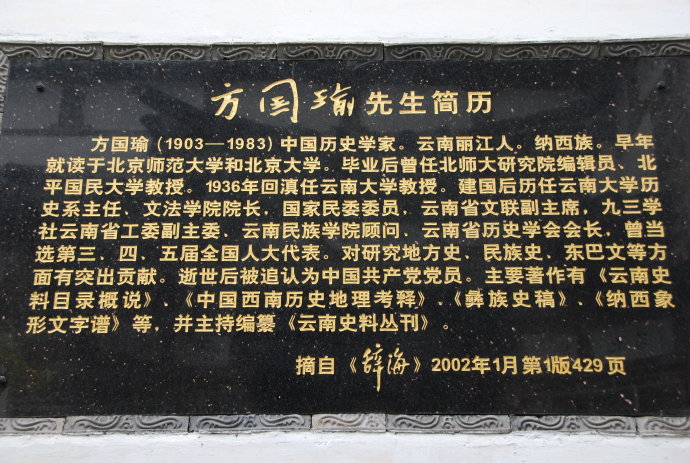
After the founding of the New China in 1949, Fang successively served as a deputy director of Jiu San Society of Yunnan Province, member of Ethnic Affairs Commission of the People’s Government of Yunnan Province, member of Ethnic Affairs Committee under the National People’s Congress, deputy of the 3rd , 4th and 5th the National People’s Congress, adviser to the Compiling Board of Chinese History and Chorography, adviser to Ethnology Research Society of Southwest China, and counsel of China Education Association.
¡¡¡¡¡¡
Ever since the 1950s, he tutored 3 post graduates, 1 doctoral student and two international students. He wrote many books, to name a few, Brief Introduction to Catalogues of Historical Records of Yunnan, Table of Pictographs of Naxi, Historical Manuscript of Yi nationality, Exploration on the History and Geography of Southwest China. He led the editing and charting task for The Atlas of the Chinese History (Southwest China Section). Fang is an explorer and foundation layer for the research of local history of southwest China and ethnic minority history. He was reputed as “an outstanding figure of Yunnan”, “a giant pillar of Yunnan history” and “a master of Yunnan academic research.
About Fang Guoyu's Former Residence in Lijiang Ancient Town
[NextPage]
CL.A.U.D.I.A. is a project dedicated to the study of Naxi people culture and Dongba tradition: CL.A.U.D.I.A. (hence CLAUDIA) acronym for Computational and Updatable Dongbas Iconographic Archive.
CLAUDIA project is focused on making an innovative dictionary of Dongba pictographs, founded on a system of classification and index plates of signs, the latter made by empirical methodology named ICONOGRAPHIC PRIMES, which the author derived from A. Wierzbicka N.S.M. – Natural Semantic Metalanguage theories.
CLAUDIA project is grounded on previous Dongba dictionaries and works, and is an interdisciplinary system implemented with an eye to the study literature of other pictographic/hieroglyphic writing systems (Egyptology and Mayan), thought and aimed for dissemination and diffusion of knowledge of Naxi-Dongba pictographic tradition, also to make the latter easier understand and enjoyed by novices.
Author's thought CLAUDIA to be realized both as printed edition and as online resources, a digital humanities application as an innovative and web available dictionary of Dongba pictographs.
Available sources and resources for the study of Dongba pictographic manuscript tradition, from CLAUDIA's point of view, should be resumed into:
Dongba pictographs' dictionary
Study works about Naxi culture, Naxi people and Lijiang history, Dongba tradition
Dongba pictographic tradition documents themselves
CLAUDIA's attention is particularly focused on dictionaries, and among them expecially looks at:
Rock Joseph Francis Charles, 1963 A 1Na-2Khi-English encyclopedic dictionary, Serie Orientale Roma, XXVIII
Rock Joseph Francis Charles, 1972 A 1Na-2Khi-English encyclopedic dictionary. Gods, Priests, Ceremonies, Stars, Geographical Names, Serie Orientale Roma, XXVIII
·½¹úè¤, ºÍÖ¾Îä - Fang Guoyu; He Zhiwu, 1995 ÄÉÎ÷ÏóÐÎÎÄ×ÖÆ× - Naxi xiang xing wen zi pu ÔÆÄÏÈËÃñ³ö°æÉç, Kunming Shi : Yunnan ren min chu ban she: Yunnan sheng xin hua shu dian fa xing
ÀîÁزÓ; Li Líncàn, 2001 ÄÉÎ÷ÏóÐÎÎÄ×Ö×Öµä - naxizu xiangxing biao yin wenzi zidian, Yúnnán Mínzú Chubanshè
ºÍÆ·Õý - Hè pin zhèng, 2004 –|°Í³£ÓÃ×Öµä(hÓ¢ŒÕÕ) - Naxi Dongba Pictographic Dictionary
Janekovic Dragan, 2005 Na-si: srpski recnik, Beograd: Narodna biblioteka Srbije
Each one of that works presents pictographs with relative transcriptions in Naxi language, but authors used different solutions and rules in pictographs' latinization, accents orthography and phonetic transcription.
Being available at today “ÖйúÉÙÊýÃñ×åÓïÑÔ¼òÖ¾´ÔÊé - Zhongguo Shaoshu Minzu Yuyan Jianzhi Conshu" 689 – 784 CLAUDIA means to consider it as the more recent and official Academic study of Naxi language grammar, thus to adopt that work's solutions of transcription of Naxi language for romanization of Dongba pictographs. In the same time, CLAUDIA means, once that is available such standard, to build equivalence plates for crossing references with works mentioned above.
Another characteristic of dictionaries available at today is the lacks of attestations and contexts references for pictographs. This except for Rock’s work, who used to refer to manuscripts he possessed as private collection or sell to Institution like the Harward-Yenching, but Rock attestations' and references' system is just limited in quoting the manuscript page where pictographs appeared within, without appropriate samples of context, as portions of text where the pictographs was taken.
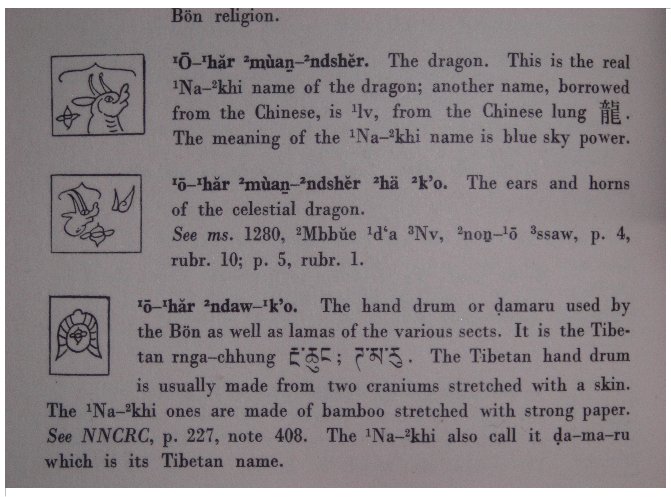
With an eye to some other similar writing system works, as A. Erman and H. Grapow, 'Worterbuch der agyptischen Sprache' - landmark study for Egyptology - seems plausible to think about the possibility of making an innovative dictionary of Dongba pictographs with a complete and satisfactory system of references and contexts' quotation, especially for poly-semic and poly-phonic pictographs, respectively one pictograph with more then one meaning and one pictograph with more then one reading, who could be disambiguated just by context.

In his experimental online draft-works published on www.xiulong.it the author developed a presented to Kunming's 2009 “new horizons in Naxi study" congress a system for dictionary entries adopting and calibrating the structure of Grapow Worterbuch: in the top middle the image of the pictograph selected, on the left side the most common orthography for the pictograph selected with latinization, IPA, translation and commentary.
On the right side quotation of dictionary references with relative orthography, under it available contexts and references in Dongba manuscript corpus where pictograph selected appears within.
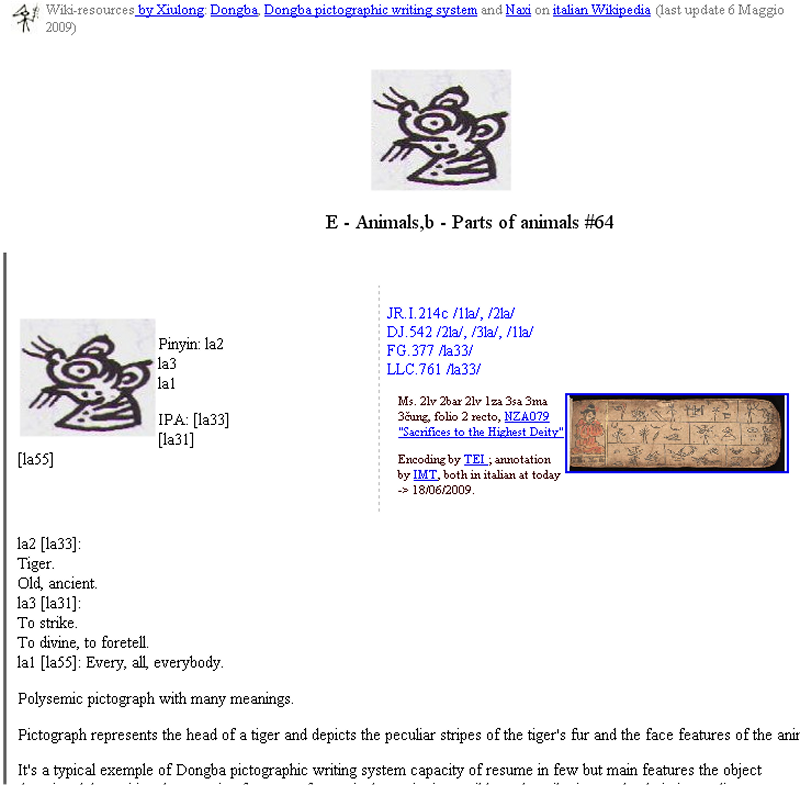 Screen-shot directly taken from CL.A.U.D.I.A. draft-works presented on Kunming 2009 congress
Screen-shot directly taken from CL.A.U.D.I.A. draft-works presented on Kunming 2009 congress
Today the layout of CLAUDIA dictionary entries is changing for a better, more user-friendly and interactive interface.
As previously introduced CLAUDIA is a project focused on making of a dictionary of Dongba pictographs, founded on an iconographic classification of pictographs, a system of iconographic index plates, and a complete dictionary with of attestations, quotations and references; CLAUDIA project features should also be resumed as follow:
GROUNDING
with regard to previous dictionaries works (references, translations, quotations, etc...)
regarding to Dongba literature study works (commentary and notes)
regarding to Naxi language study literature, (standard orthography and pinyin, IPA transcription)
INTERDISCIPLINARITY
regarding to other pictograph/hieroglyph writing system study literature, as Egyptology and Mayan
regarding to Anna Wierzbicka reductive paraphrase methodology in N.S.M. – Natural Semantic Metalanguage theory, for a re-calibrated and innovative classification of Dongba pictographs
regarding to TEI standard, and digital humanities resources, for web publishing of iconographic index plates and Dongba dictionary
DISSEMINATION
aiming at diffusion and spreading knowledge of the pictographic tradition
making pictographs easier to be understand and enjoyed by novices
taking Dongba pictographs beside the other historical pictograph/hieroglyph writing system
CLAUDIA work consist in a systematic study of pictographs’ iconography and structural features: pictographs have to be classified following iconographic criteria, and during the classification will be also made the creation process of iconographic index plates.
Study of Dongba manuscripts also evinced 2 mains structural features for pictographs:
BASIC PICTOGRAPHS
COMPOSED PICTOGRAPHS
Author also distinguish COMPOSED PICTOGRAPHS into
COMPLEX UNITS of COMPOSED PICTOGRAPHS
FUSION-DERIVED UNITS of COMPOSED PICTOGRAPHS (cfr.3.b)
Previous dictionary works will be systematically quoted into CLAUDIA’s references also reporting relative orthography.
In ex. pictograph  : it is recorded in Dragan Janekovic as the 557th pictograph, transliterated with /la33/ orthography; in Fang Guoyu and He Zhiwu at pg. 409, the 2nd (a=1st, b=2nd, etc...) pictograph transliterated as /l?33/; in Hè Pin Zhèng it's on pg. 43, the 6th pictograph with /l?33/ orthography and finally in Li Lincan it's the 761st pictograph, transliterated /la33/.
: it is recorded in Dragan Janekovic as the 557th pictograph, transliterated with /la33/ orthography; in Fang Guoyu and He Zhiwu at pg. 409, the 2nd (a=1st, b=2nd, etc...) pictograph transliterated as /l?33/; in Hè Pin Zhèng it's on pg. 43, the 6th pictograph with /l?33/ orthography and finally in Li Lincan it's the 761st pictograph, transliterated /la33/.
In CLAUDIA online version each pictograph of iconographic plates is an hyper-link: by clicking on it user opens - in a new dedicated page - a complete pictograph schedule with translation, commentary, notes and attestation of selected sign.
In that complete page, below selected pictograph, are listed all its variants attested.
This is the author's idea for CLAUDIA as a Dongba Pictograph Dictionary, thought and implemented as wide-web enjoyable resources. References of dictionaries will be quoted by abbreviations as below: (this isn't a definitive choose of dictionaries and works to be quoted as references. CLAUDIA system is completely updatable)
, Yúnnán Mínzú Chubanshè
Janekovic Dragan, 2005 Na-si: srpski recnik, Beograd: Narodna biblioteka Srbije
FG. : ·½¹úè¤, ºÍÖ¾Îä - Fang Guoyu; He Zhiwu, 1995 ÄÉÎ÷ÏóÐÎÎÄ×ÖÆ× - Naxi xiang xing wen zi pu
HPZ. : ºÍÆ·Õý - Hè pin zhèng, 2004 "–|°Í³£ÓÃ×Öµä(hÓ¢ŒÕÕ) - Naxi Dongba Pictographic Dictionary"
DJ. : Dragan Janekovic, 2005 "Na-si: srpski recnik" - Beograd: Narodna biblioteka Srbije
JR.I. : Joseph F. C. Rock, 1963: "A 1Na-2Khi-English encyclopedic dictionary", I volum3
LLC. : ÀîÁØ²Ó Li Líncàn, 2001 " ÄÉÎ÷ÏóÐÎÎÄ×Ö×Öµä - naxizu xiangxing biao yin wenzi zidian [A dictionary of Naxi pictographs]"
Author means to look for available resources and methodologies, not necessary focused on Dongba pictographs, suited to improve the quality of work, thus by “interdisciplinarity" here is meant to adopt and re-calibrate all methodologies and works useful for dictionary making and pictographs' study.
Firstly, it seemed plausible to look for other pictographic and hieroglyphic study literature, specially at Egyptology (author's got MA in Egyptology in Pisa University in 2004) and Mayan, looking for methodologies and patterns which could be re-calibrated and adopted in Dongba dictionary writing.
The works the author looked at during CLAUDIA implementation are:
A. Erman and H. Grapow, 'Worterbuch der agyptischen Sprache', fundamental for introducing in CLAUDIA
complete dictionary structure planning
introduction of attestations, references and contexts. Those systematically quoted for each pictograph entry in complete dictionary pages
chronological evolution and orthography variations, as contextualized study of pictographs (cfr. Appendix )
A. Gardiner, ‘Egyptian Grammar’, fundamental for introducing in CLAUDIA concepts of
innovative iconographic classification of Dongba pictographs needed
iconographic index plates of pictographs for fast retrieving, without any user’s competence needed in reading pictographs
COE D. Michael, 2001 “reading the Maya Glyphs", fundamental for introducing in CLAUDIA concepts of
basic pictographs and complex pictographs
among complex pictographs distinction of composed-units and fusion-units
syllabary, to be implemented for Geba syllable-graphic signs and to be experimented for most common basic pictographs
Wierzbicka A., 1972, 1980b, 1992, 1996, 1997, 2001; Gottard C., 1997, 2008, fundamental for introducing and developing in CLAUDIA
concept of ICONOGRAPHIC PRIMES which is the fundamental main theory both for classification of pictographs and for making iconographic index plates
reductive paraphrase method for pictographs classification and identification of ICONOGRAPHIC PRIMES
TEI guidelines, fundamental for introducing in CLAUDIA
web resources implementation following the standards required by TEI recommendations for digital texts encoding and web publishing
CLAUDIA aims to be an instrument for dissemination of Dongba tradition, for spreading and diffusing knowledge of Naxi culture, manuscript tradition and Naxi pictograph art.
Looking at the methodologies and solutions of the other writing systems' studies landmark works author also aims to improve highest qualities of Dongba dictionary itself, taking Dongba pictographic writing system and Dongba manuscript tradition as nearest as possible to Egyptian and Mayan Hieroglyphic writing systems; CLAUDIA, as a tool for dissemination is based on:
an innovative iconographic classification of pictographs
an iconographic index plates of pictographs
and direct links between plates elements and dictionary entries
all sum into an useful instrument for fast consultation of dictionary without any a-priori required knowledge of reading and/or meaning of pictographs, making them easier to be understand and enjoyed also by novices.
In its landmark work for Egyptology sir Alan Gardiner inserted as appendix to his Egyptian Grammar a concise dictionary of Hieroglyphs previously introduced by some index plates of the Hieroglyphs themselves.
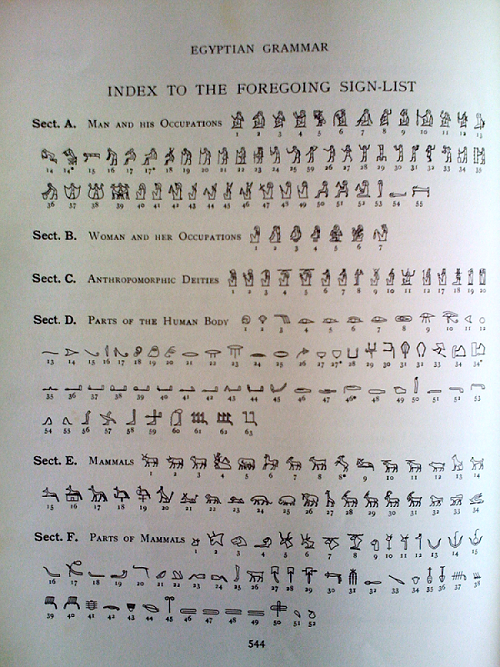 Gardiner Hieroglyphs index plates
Gardiner Hieroglyphs index plates
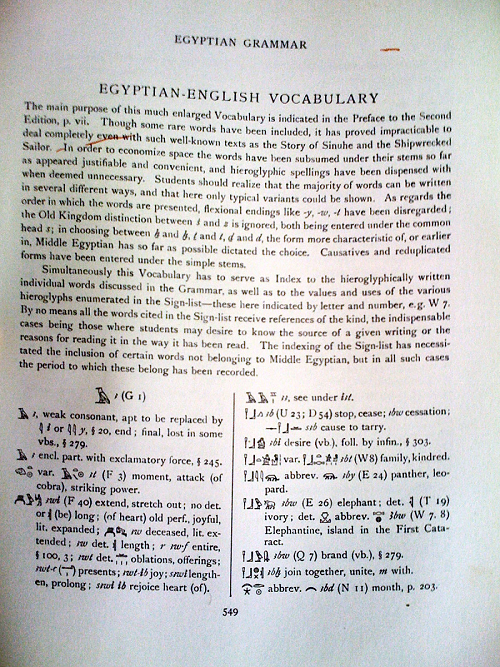 A page from Gardiner's Hieroglyphs dictionary. Entries of dictionary are directly linked to index plates, thus an user could faster and easier identifies hieroglyphs without knowing its reading/s and/or meaning/s; dictionary is thus enjoyable also by novices.As Grapow did, on the top middle of the Gardiner short dictionary, the basic hieroglyphs were written, then followed all derived forms and variants which Gardiner attested in his work..
A page from Gardiner's Hieroglyphs dictionary. Entries of dictionary are directly linked to index plates, thus an user could faster and easier identifies hieroglyphs without knowing its reading/s and/or meaning/s; dictionary is thus enjoyable also by novices.As Grapow did, on the top middle of the Gardiner short dictionary, the basic hieroglyphs were written, then followed all derived forms and variants which Gardiner attested in his work..
Being Dongba pictographic writing system into Dongba manuscript tradition full of poly-semic and poly-phonic phenomena, Gardiner solution of a system of index plates and related dictionary seems to be as the most useful and the easiest methodology to be re-calibrated and adopted into dictionary of Dongba pictographs, making pictographs retrievable without involving any readings and meanings required knowledge.
In ex., pictograph 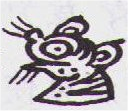 attested in Folio II recto of NZA079 manuscript, library of Congress of Washington online collection: poly-phonic and poly-semic pictographs, with latinizations, [IPA] transcription and relative translations:
attested in Folio II recto of NZA079 manuscript, library of Congress of Washington online collection: poly-phonic and poly-semic pictographs, with latinizations, [IPA] transcription and relative translations:
[la33]: Tiger. Old, ancient
la3 [la31]: To strike. To divine, foretell
la1 [la55]: Every, all, everybody
Is plausible to hypothesize that novices couldn’t know none of the readings of the pictographs, neither the meanings, except the obvious one: tiger. It also seems obvious to hypothesize about everybody's capacity of immediate identification of pictograph with the iconography of an animal, and this just in a shot-looking. A deeper look to pictograph may could suggest to any generic user that the animal portrayed is a feline, and the portrait isn't one of a complete feline, but just a part of this animal, more exactly the head of a feline.
The author considered such observations fundamental into his project for an innovative Dongba pictograph dictionary: the latter could be structured into indexed classes as Gardiner did, and such classes have to be deduced from a classification work of Dongba pictographs.
Substantially Dongba dictionary work then would be structured as a system of index plates directly linked to dictionary entries. Each pictograph had to be included just once with a single index number into one plate, and each plate had to be labeled by one capital letter.
Users could then identify pictographs like in Gardiner dictionary by looking for them into plates, and once found, then following relative index number linking directly to full-dictionary voice; moreover such system and structure of dictionary?plates was just suited both for a printed edition and online implementation.
As Gardiner developed for Egyptian Hieroglyphs, the way that author chosen for classification of Dongba pictographs and implementation of index plates is grounded on ICONOGRAPHIC CRITERIA, a methodology of classification that the author has to do without any noises and interferences from any other pictographs' features, as semantic, phonetic, etc...
In other words, the innovative way of Dongba pictographs classification the author meant, he made by an empirical identification of iconographic and peculiar patterns recurring into Dongba pictographs whole corpus.
From the study of Dongba manuscripts and Dongba tradition literature the author hypothesized that is possible to identify a nucleus of BASIC PICTOGRAPHS (with many variants), and such BASIC PICTOGRAPHS the Dongbas used to assembled together to make COMPLEX PICTOGRAPHS. Moreover, author hypothesized that, as in Mayan hieroglyph writing system, COMPLEX PICTOGRAPHS could be obtained with 2 different techniques:
putting beside some graphic units making a COMPOSED UNITS of COMPLEX PICTOGRAPHS, ex.:  cow +
cow +  ax =
ax =  to look for a partner, phonetic use of pictographs. In abstract formula this instance could be resumed as: A + E = [AE]
to look for a partner, phonetic use of pictographs. In abstract formula this instance could be resumed as: A + E = [AE]
melting together graphic units making a FUSION UNITS of COMPLEX PICTOGRAPHS, ex.:  young man, shepherd +
young man, shepherd +  rocks +
rocks +  foot =
foot =  the Lu demon of suicide descending. In abstract formula this instance could be resumed as: A * E ? [Æ]
the Lu demon of suicide descending. In abstract formula this instance could be resumed as: A * E ? [Æ]
In this paper FUSION PICTOGRAPHS are meant as a result in a willing technique process of the act of writing which consist in melting together two or more graphic units, (elementary, complex and/or or both) by fusion and loosing of the signs' original boundaries and contours, making a new and unique complex graphic-significant unit in which single graphics limits and order of composition of pictographs are modified, partially omitted or totally lost.
From a linguistic point of view fusion pictographs could be seen as a GENERATIVE aspect of Dongba pictographic writing system, producing hypothetical infinite new combinations from a limited number of significants; in the meantime, author's interpretation of features of FUSION PICTOGRAPHS' TECHNIQUE (lost of boundaries, lost contours of block of significants, signs that strongly influence one each other) are interpreted as one of the evidences that suggest to consider Dongba pictographic writing system into manuscript's tradition as an hypo-articulated communication system, concept derived from Phonetic and Prosody theories (Albano & Maturi, 1995: 18 – 20)
Sign  is a perfect sample of FUSION PICTOGRAPH. It means “[the] lu demon of suicide descending", (Rock J., 1939: 22) and it is the result of the fusion of more graphic units: the central anthropomorphic on
is a perfect sample of FUSION PICTOGRAPH. It means “[the] lu demon of suicide descending", (Rock J., 1939: 22) and it is the result of the fusion of more graphic units: the central anthropomorphic on e a shepherd, or a young man, above and melted to his head the pictograph
e a shepherd, or a young man, above and melted to his head the pictograph  lu rocks used both as phonetic complements for demons class' name specification, and as symbolic key to allude to ritual suicide committed by putting some heavy rocks inside the pockets of the garment, and letting oneself drown in water. (Rock, 1937)
lu rocks used both as phonetic complements for demons class' name specification, and as symbolic key to allude to ritual suicide committed by putting some heavy rocks inside the pockets of the garment, and letting oneself drown in water. (Rock, 1937)
At the end of stretched out leg the pictograph  foot melted to the central graphic unit as determinative of movement.
foot melted to the central graphic unit as determinative of movement.
Dictionary has obviously to include such kind of fusion pictographs as every attested COMPLEX PICTOGRAPHS, but the dictionary's structure projected by author, inspired from Erman – Grapow and Gardiner works for Egyptian provides to make them accessible as DERIVED FORMS of a BASIC PICTOGRAPHS.
By BASIC PICTOGRAPHS the author here means the fundamental graphic units that subsume complex units, alias complex pictographs.
In  case, fundamental graphic unit should be identified with the BASIC PICTOGRAPH
case, fundamental graphic unit should be identified with the BASIC PICTOGRAPH  .
.
In other words, COMPLEX PICTOGRAPHS WON’T BE INCLUDED INTO INDEX PLATES but they WILL BE into complete dictionary pages listed as variants and derived forms of the BASIC PICTOGRAPH which constitutes their dominant and main graphic unit (the latter obviously included into index plate).
In CLAUDIA online draft-work, by selecting a basic pictograph X from an index plate implemented (at today just animal prime is done, with relative and nested sub-groups: complete animal and parts of animals) user will access to the complete dictionary entry page for selected pictograph, and in this page he/she will found the list of all derived pictographs having X as basic graphic unit; please cfr. sample below and try the online demo.
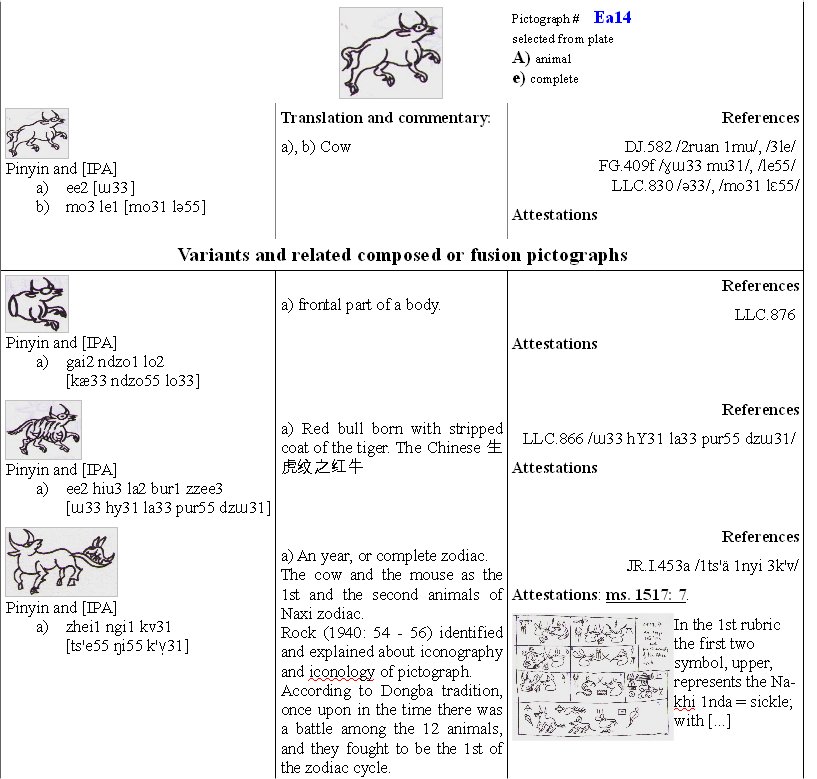
Dongba pictographs' iconographic plates and dictionary project is closely related and dependent by an innovative and functional classification of basic pictographs.
During CLAUDIA experimentation, works of classification and plates making proceeded parallels, because from iconographic classification of pictographs the author identified some recurring iconographic patterns or meta-themes into Dongba pictographs corpus, so from this patterns he build the system of classes to gather basic pictographs within.
Author names such recurring iconographic patterns are ICONOGRAPHIC PRIMES, terminology he was inspired by Anna Wierzbicka's concept of SEMANTIC PRIMES in her N.S.M. - NATURAL SEMANTIC METALANGUAGE theory.
Being identification of ICONOGRAPHIC PRIMES a process of individuation of PRIMITIVE ICONOGRAPHIC META-THEMES RECURRING into Dongba pictographs corpus, then ICONOGRAPHIC PRIMES consist in a sort of hidden ICONOGRAPHIC CORE of pictographic writing system, a concept similar to SEMANTIC CORE of N.S.M. Theory.
Each ICONOGRAPHIC PRIME has to be:
GENERAL: iconographic prime implies some iconographic patterns or features present in many pictographs and, once identified, each PRIME has to be used to group many basic pictographs into a general class. An ICONOGRAPHIC PRIME could contains some nested SUB-PRIMES, as in CLAUDIA demo COMPLETE ANIMALS and PARTS OF ANIMALS are nested SUB-PRIMES of the wider ANIMAL PRIME.
DISTINCTIVE: although a), each ICONOGRAPHIC PRIME must resumes peculiar and absolutely non ambiguous features
PURE: each prime has not to be contaminated by any other features, as semantic, phonetic, etc...
As the concept of ICONOGRAPHIC PRIMES the author was inspired and derived by Wierzbicka N.S.M. theory, as the methodology for ICONOGRAPHIC PRIMES identification is inspired yet from Wierzbicka’s work, more exactly from REDUCTIVE PARAPHRASE METHODOLOGY, obviously with re-calibration needed to make it suited to Dongba pictographs.
The way of working for ICONOGRAPHIC PRIMES identification (which coincides also to pictographs classification work) in few words could be resumed with a recursive self-posing question; with an “ICONOGRAPHIC PRIME POINT OF VIEW" the author self-posed in front of pictographs and asked himself: what is this?
In ex., pictographs  ,
,  and
and 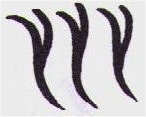 classification methodology worked as exemplified below
classification methodology worked as exemplified below
ex. 1.  what is this ?
what is this ?
a COMPLETE portrait of a TIGER
a FELINE
an ANIMAL
a LIVING BEING
ex. 2.  what is this? This is no more a COMPLETE portrait of a tiger at well, but
what is this? This is no more a COMPLETE portrait of a tiger at well, but
the portrait of the HEAD of a TIGER.
Thus a PART OF a TIGER,
and again a FELINE,
an ANIMAL,
a LIVING BEING.
From samples 1 and 2 was possible to identify a wider general prime, nested within the general (but less wide) primewith two sub-primes:and.then contains another sub-primewhich contains the other very specific, whileprime contains .
ex. 3.  what is this? This pictograph means the tiger’s striped fur, and it is reported in dictionaries listed in 1. as following:
what is this? This pictograph means the tiger’s striped fur, and it is reported in dictionaries listed in 1. as following:
JR.I.17a /3bber/
DJ.497 /3par/, /2lau 3par/
FG.339 /par55/, /la33 par55/
LLC.861 /kæ31/, /pur55/, /pur55 kæ31/, /pur55 w?31/
Except for Rock, who organized 1st volume of his dictionary disposing pictographs by their reading in alphabetic order, the other authors classified and gathered this pictograph into “animal" class.
Once he was in front of ex.3., the author asked himself if this pictograph, and moreover this kind of pictographs, really could be seen as belonging to “animal" class, without any semantic knowledge. He hypothesized that, especially for novices, it isn’t immediately identifiable a sign belonging to any animals' groups, especially without having knowledge of its semantic value.
Following the previously exemplified primes' methodology ex.3.  appeared just to be made by some STROKES, more exactly by 3 STROKES, OBLIQUES and DESCENDING FROM LEFT TO RIGHT, and absolutely NOT LIVING BEING.
appeared just to be made by some STROKES, more exactly by 3 STROKES, OBLIQUES and DESCENDING FROM LEFT TO RIGHT, and absolutely NOT LIVING BEING.
Similar situation could be found in such kind of pictographs, like  : it was classified in Li Lincan dictionary at page 868 among animals' signs, translated “hair or fur of animal" with orthography /fv33/. According to ICONOGRAPHIC PRIMES methodology for ex.4. the author evinced the following primes:
: it was classified in Li Lincan dictionary at page 868 among animals' signs, translated “hair or fur of animal" with orthography /fv33/. According to ICONOGRAPHIC PRIMES methodology for ex.4. the author evinced the following primes:
STROKES
4 STROKES
OBLIQUE
DESCENDING
FROM RIGHT TO LEFT
NOT A LIVING BEING
According to author's point of view, gathering ex.3. and ex.4.
and ex.4. into animals' group is a perfect sample of contamination of semantic features, and he hypothesized that this contamination could cause ambiguities and difficulties in retrieving signs into dictionaries.
into animals' group is a perfect sample of contamination of semantic features, and he hypothesized that this contamination could cause ambiguities and difficulties in retrieving signs into dictionaries.
Author classified in CLAUDIA  and
and  both as BASIC PICTOGRAPHS belonging to STROKES PRIME, so he gathered them into STROKES INDEX PLATE. Such plate has to be organized with many nested sub-primes as:strokes,,,,, etc...
both as BASIC PICTOGRAPHS belonging to STROKES PRIME, so he gathered them into STROKES INDEX PLATE. Such plate has to be organized with many nested sub-primes as:strokes,,,,, etc...
In this way, signs retrieval should be easier, faster and independent form Dongba pictographs' meaning and pronunciation, probably successfully also by novices.
In the Kunming 2009 congress the author presented an experimental draft-work for CLAUDIA: the PRIME ANIMAL and relative nested two sub-primes COMPLETE and PARTS OF animals he implemented.
Index identification number of basic pictographs gathered into ANIMAL – COMPLETE plate is on top left of each element of plate.
Under image of each pictograph: its latinization, [IPA transcription], /main dictionaries references with related orthography annotations/ and finally basic translations. (n.b.: Such information aren't fundamental in plates implemented, but since the project is experimental, the author needed them to be to output for further easier operations and manipulations.)
In CLAUDIA, as online edition of Dongba iconographic plates and dictionary, each base pictograph of index plate is an hyper-link, pointing directly to relative dictionary page. The latter reports:
complete entry for selected pictograph
complex pictographs, (composed and fusion units) having the selected basic pictograph as the main graphic unit they derived from
In author's experimental draft-work the system of dictionary entries is adopted and re-calibrated to Dongba pictographic writing system form Erman - Grapow's Egyptische Wertbok.
On the top middle the image of the basic signs selected, then follow the most common orthography for the selection, its latinization, IPA, translation and commentary; quotation of dictionary references with relative orthography are reported as well.
Under, if available, contexts and references of Dongba manuscripts where pictograph appears within.
Admission Fee:¥0

You will only receive emails that you permitted upon submission and your email address will never be shared with any third parties without your express permission.
